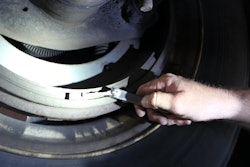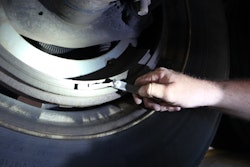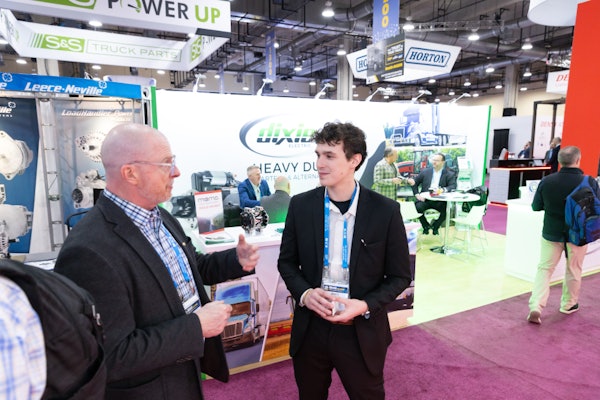Batteries can be traced back more than two-and-a-half centuries when Benjamin Franklin coined the term to name an array of electrically charged glass plates he created in 1748.
While batteries have obviously become more powerful and efficient during the last 260 years, for the most part, the truck batteries you stock and sell have pretty much stayed the same for decades.
However, recent regulatory, legislative and technological changes – coupled with the recent and not-forgotten surge in diesel fuel prices – have brought the humble battery into the trucking industry’s spotlight like never before. Batteries have the potential to improve fuel economy in both mobile and idling situations; keep refrigerated loads cool; and even power urban delivery trucks all by themselves.
Modern batteries will soon produce enough electricity to power a host of conveniences without diesel engine support, while maintaining their current long lifespans and keeping overall unit size and weight within current parameters. Battery makers believe new technologies will allow them to meet these considerable challenges, but they also admit they have their work cut out for them.
While it’s not fair to say that battery development has been stagnant, it is fair to say that automotive and trucking battery development has been evolutionary instead of revolutionary.
“For the most part, battery manufacturers reached a performance plateau in terms of what could be accomplished and, beyond the natural desire for longer battery life, had few outside factors spurring exponential development,” says Mil Ovan, senior vice president and co-founder of Firefly Energy.
Battery makers have used key components that have not changed in more than 100 years, such as lead metal grids that form the basis of traditional, inexpensive flooded lead-acid batteries, Ovan says. Conventional batteries have been sufficient for starting vehicles. But today batteries are being asked to perform an ever-increasing array of jobs, and the “perfect storm” of anti-idling laws and unpredictable fuel prices has added further urgency to the need to develop more powerful, dependable truck battery systems, he says.
Doyle Choate, director of U.S. heavy-duty aftermarket sales for Exide Technologies, says the primary factors driving development are the increased energy needs during both key-on and key-off periods, plus the need to reduce both emissions and fuel consumption. Electronic controls and accessories, GPS systems and increasing cab comforts all add to the energy demands during key-on vehicle operation.
Maintaining cab comforts during key-off periods creates an additional and somewhat different energy requirement. And the need to minimize idle time, whether driven by regulation or fuel costs, results in more frequent starts and thus shorter recharge time between starts.
Balancing increased workload with customers’ expectations regarding lifespan is a challenge, Choate says. “Energy requirements are higher in today’s operating environment, causing batteries to be cycled deeper and more frequently than in the past. This means they can wear out in a shorter time period.”
Choate says customers usually think about battery life in terms of months when it actually should be measured in terms of cycles. “Doubling the miles driven per month means tires are likely to wear out in a shorter period,” he says. “Cycling a battery twice as frequently also will shorten the amount of time this power source is expected to last.”
Ovan agrees that the major factor driving development today is the increasing need to avoid main-engine idling as the means to power ancillary electrical loads. “Whether the loads consist of sleeper cab hotels, lift gates, air conditioning units, tank heaters, laptop computers, various truck electronic modules or required emergency lighting systems, idling the truck’s engine to power these components is in many cases no longer an option.”
New 2010 trucks with enhanced emissions reduction systems also will present a challenge, Ovan says; the urea in some of these upcoming pollution reduction systems freezes in cold temperatures and therefore must be kept warm by key-off battery power. That is yet another parasitic load that can help wear out traditional lead acid batteries prematurely. “Pollution reduction, regulatory compliance, reduced engine wear and improved fuel savings are all driving the demand for a better battery,” Ovan says.
Perhaps today’s most important battery technologies for end users relate to auxiliary power units (APUs), Ovan says. “Customers have wanted a ‘battery APU’ alternative to either idling the main engine or having to resort to noisy and maintenance-intensive diesel APUs.”
The frustration with battery-powered APUs arises due to the fact that a traditional lead acid battery – either flooded or absorbed glass mat (AGM) – suffers from several performance limitations, Ovan says. These include battery runtime, which fades after only a short number of discharges; poor cold temperature performance; long times to recharge the battery; and limited life.
Stacking more batteries onto a truck would solve these problems, but that’s not a viable solution. “The challenge of weight is constant,” Choate says. “Batteries can never be light enough – every pound saved is more than another pound of load delivered after the additional supporting mechanical structure is subtracted.”
Size is not quite as critical, but smaller is better, and also reduces mechanical structure needs, Choate says. “Getting more power and energy out of less material without compromising performance and life is a development effort that never ends.”
DEEPER DISCHARGE, FASTER RECHARGE
Several alternatives to flooded lead-acid batteries are already on the market today and are designed to offer trucking companies improved performance in the field. Most of the attention today is on AGM and lithium-ion batteries as technologies built to handle sustained APU use and other emerging electrical requirements on trucks.
Like conventional flooded batteries, AGM batteries are of lead-acid composition, meaning sulfuric acid and lead oxide are the primary active ingredients. “The fundamental difference is how the acid is positioned in order to react with the lead oxide,” Choate says.
In flooded lead-acid batteries, there is a larger volume of diluted acid (electrolyte), which fills the cell cavity around and over the top of the positive and negative plates.
In AGM construction, the electrolyte is absorbed completely in the nonwoven spun glass micro-fiber mats that act as separators and insulators between the positive and negative plates.
Since the separators essentially are the same size as the plates, they hold the electrolyte in place all the way to the top of the plates and eliminate the need for coverage over the plates.
Choate says this configuration allows for maximum utilization of the space available within the battery case through the use of taller plates. Since the size of the case is controlled by Battery Council International (BCI) standards for the given group size, greater space utilization affords the opportunity to increase the cranking amps or reserve – or both – versus a flooded battery of the same group size.
In anticipation of no-idle legislation, Exide introduced its RoadForce AGM battery series. Choate says the batteries are engineered to handle the greater demands of the no-idle environment – such as deeper discharge, faster recharge and more cycles – than a conventional flooded product.
“There are other roles beyond cab comfort applications that are just as important to reducing idling time,” he says. “By using batteries with AGM technology, delivery trucks operating battery-powered lift gates can eliminate the need to run the engine while operating the lifts.”
Choate says a beverage distributor who tested the RoadForce AGM-200 batteries for its lift gates found they could shut off the engine immediately upon stopping and still have more rail gate power throughout the day than previously; the fuel savings allowed them to refuel every four days rather than three. Burning 25 percent less fuel should result in a reduction in emissions, he says. “Even where ‘no-idle’ is not yet law, operators can reduce costs, be a good green citizen and be ready to comply once this type of legislation reaches their locations.”
CAN LITHIUM BATTERIES DELIVER?
Lithium-ion batteries, which have proven to be successful powering portable electronic devices, also are garnering a lot of attention in trucking applications.
“Lithium is the lightest and most energy-dense battery technology in the world today,” says Robert Owen, director of OEM relations for Entertek Solutions. “They are also nontoxic.” Owen compares what lithium ion could do for trucks to what it did for cell phones: It made them both smaller and longer-lasting on a single charge.
Not everyone is sold on lithium batteries in the long run, however. Firefly’s Ovan points to laptop battery fires reported in the mainstream media as a potential safety hazard in trucking applications. And Exide’s Choate notes that while lithium-ion batteries are attractive for their high-capacity capability in a lighter package, he is concerned about pricing and their ability to withstand rigorous highway hauling work.
“Presently, there is a very significant price premium for the additional capacity offered by lithium batteries,” Choate says. “And not enough information is known about the long-term durability and performance of the batteries and their required electronic monitoring and control systems in truck applications.”
Large-format lithium battery systems combine individual lithium battery cells, sophisticated software and electronics. Today’s onboard electronic control modules make lithium batteries possible for truck fleets, Owen says. “A lithium battery system without the software is like your computer without any programs or even an operating system,” he says. “It simply will not work.”
Smart Energy Solutions is working on the sophisticated control systems required of truck-specific lithium-ion batteries. Kimberly Julevic, the company’s sales and marketing manager, believes that battery management systems eventually will become more important for all battery types as electrical demands increase in trucking applications.
“Our Battery Brain control system allows all of the secondary application for the available power in the battery, but protects the required energy needed to perform the battery’s basic requirement – starting large engines in extreme weather,” Julevic says. Smart Energy Solutions is developing improved monitoring, switching and storage capabilities for batteries that will allow more flexibility for traditional and hybrid systems, and allow a battery the ability to store more energy in the same size while doubling the battery life, she says.
The challenge facing lithium battery manufacturers is developing the electronic systems that will control the huge amounts of energy generated by the batteries without allowing the system to damage itself.
“Currently, customers expect that their batteries work every time, have no maintenance and do not cost much,” Owen says. Lithium batteries will not be cheap, but costs will come down as economies of scale increase, he says. “But in return for the extra costs, you’ll get a battery that can be one-third the weight and size of a conventional truck battery.”
Owen believes the main issue facing lithium-ion truck batteries is the lack of public or private funding required for customizing the technology for the trucking industry. “Much of the early financial support for lithium ion has gone to the automotive industry.” For example, the United States Advanced Battery Consortium – a joint effort of Detroit’s Big 3 automakers – in May awarded in conjunction with the U.S. Department of Energy a $12.5 million contract to A123 Systems to develop lithium-ion technology for plug-in hybrid-electric batteries.
Meanwhile, trucking’s recent financial woes have dried up what little funding was available, Owen says. “We have proven that we can provide an integrated battery that would provide full standby APU power, start the truck and not add any additional weight to the truck. But in today’s climate, we cannot raise the funds to bring this to market.”
You can bet, however, that a more stable economy and higher fuel prices that many observers believe are inevitable will bring renewed focus on big advances in battery technology for vehicles of all sizes.







